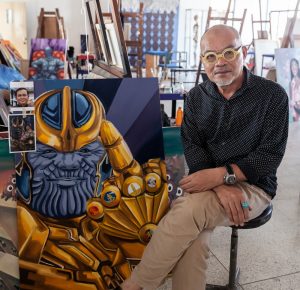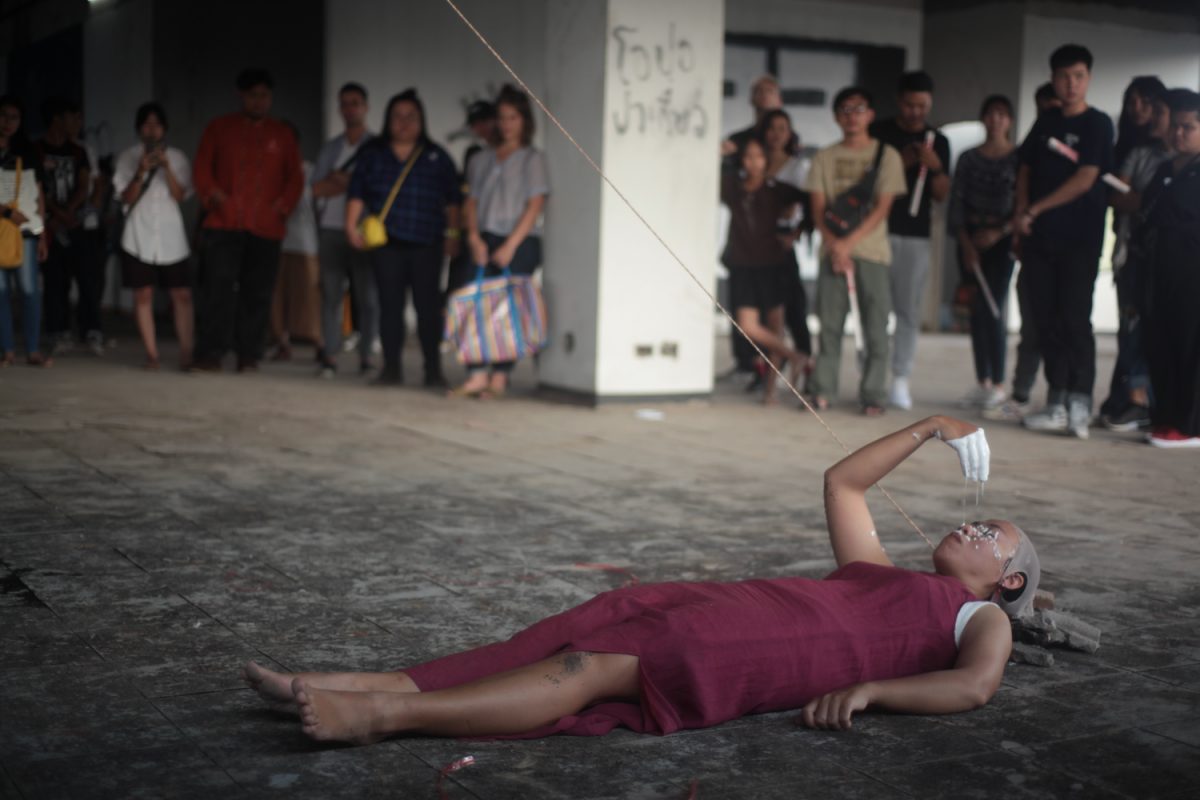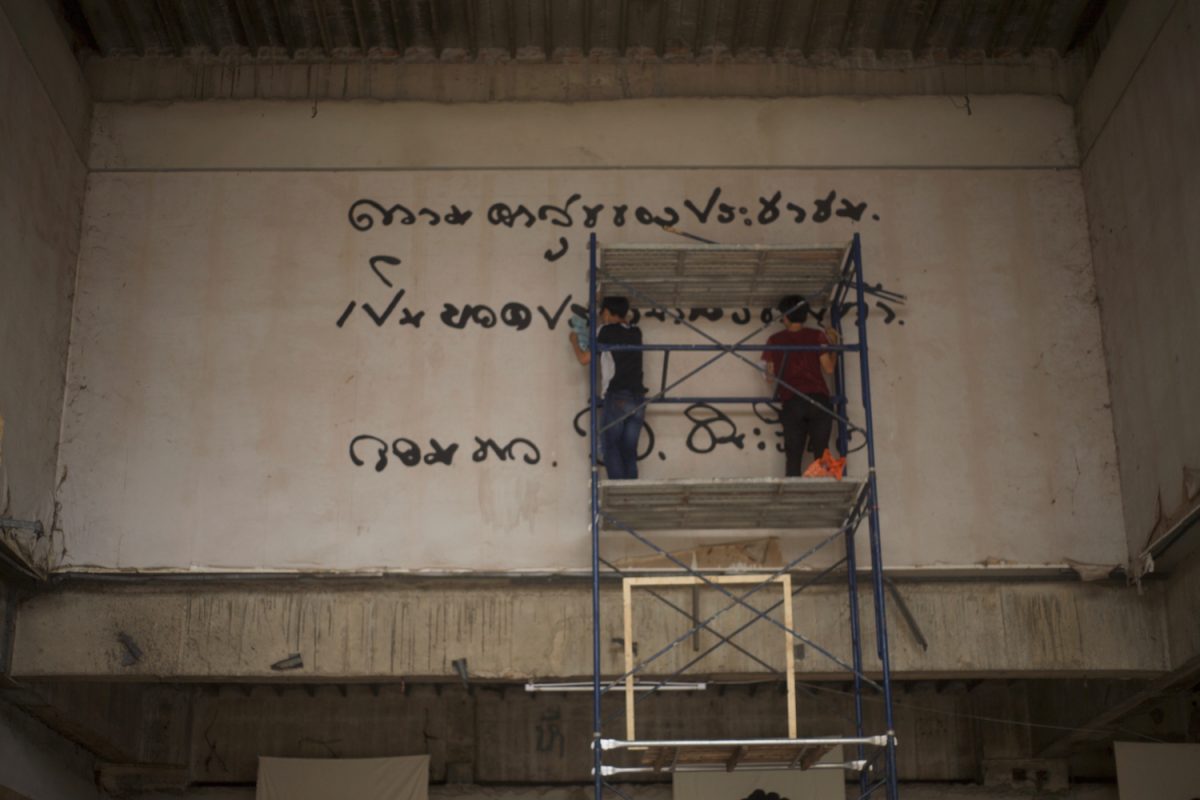INSTEAD OF USING THE WORD ‘BIENNALE,’ KHONKAEN MANIFESTO POINTS OUT THAT THE ROLE OF ART MUST BE SOMETHING BEYOND AESTHETIC EXPRESSION
Art and activism share a common adeptness at eliciting dialog with the very audiences for whom they are rendered, and are equally described by the responses they provoke as they are by the objects, actions or words they embody. Creating a public space for discourse through art (let alone activism) is, however, also the privilege of a life lived where such rights exist. art4d spoke with Thanom Chapakdee, Artistic Director and Curator of Khonkaen Manifesto 2018, an alternative art festival exploring “community art and a participatory perspective” about the importance of calling upon creative practice as a means to develop a relationship with those whom we speak not at, or to, but with. When it comes to works and words of aesthetic resistance, perhaps it is the pairing of where such interchange is spoken and with whom that grants real meaning – as our actions and our art create a space that both embodies its beliefs, and invites others to do the same.
art4d: The term ‘manifesto’ evokes a feeling of the Khonkaen Manifesto event being a start of something rather than a presentation of or reflection upon that which has already been created and achieved. I like the energy that comes with that word. Why did you choose the term ‘manifesto’?
Thanom Chapakdee: For this exhibition I wanted something that was anti the idea of a biennale or an art festival, because I am thinking that art, in our time, is not just only visual art but it can also be about ordinary people and everyone can be manifested themselves, as art. When the Communists used the term manifesto in 1847, that was about the society, politics and the people. I am using the term manifesto because during the 1930s or 1940s, Khon Kaen was used as a model and a base to announce the plan to develop the region around this area of Thailand, including the development of Khon Kaen University and Chiang Mai University. It reminded me of when a dictator announces their plan for development so why not use that word, manifesto, instead of biennale? I use it for the idea of acting as an art and an activist movement.
art4d: Is this also why you chose Khon Kaen? Was it this history of the city that called for the event to be staged there?
TC: Yes. Field Marshal Sarit Thanarat used Khon Kaen as a model to mobilize and modernize Thailand’s northeastern Isaan region and at that time he cooperated with the government to develop Mittraphap Road running from Saraburi to Nong Khai, just in front of the GF Building. There were many changes for the people in Isaan and it was also at that time that people began setting up against the Thai state as well.
art4d: Could you talk about the significance of the exhibition space? I understand that the project aims to bring to light the ways in which economic expansion and development has suppressed the local community. Why did you feel the GF Building was the most fitting space within this community to house dialog around such predicaments brought about by “progress”?
TC: The GF Building itself housed a financial company during the 90s. For me, it is a kind of metaphor for the making of a gap between people and people themselves. When the roads and modernization came, many things changed. The poor people were pushed out of the way of the city and another class of people were created within, which created a gap between rich and poor. The GF Building collapsed during the Tom Yum Kung crisis and the middle class people in Isaan lost everything. The aim of the manifesto is to let ordinary people have a voice by using their art. The people in the community around there said that this building is normally a whitecollar working building and ordinary people cannot get in or be involved; it is like a strange place for them. When we opened this building they just came and could see what happened and wonder, why could we never get in here before? People from around Khon Kaen came to visit the site not just only for the art, but also for the building itself. Of course, for the first time, it was also a kind of survey to see how we could deal with the people, and how we could ask them to join.
art4d: Artists often use their works to speak for marginalized and or underrepresented voices, both their own and those of others. In your opinion, as artists or curators, is using one’s creative practice to move toward civic engagement a responsibility that we have?
TC: I believe in that. I believe that art should be a kind of method of engagement. It is a way to engage with the people. It is not just about showing in the museum like, well anyway like BAB. I think it is too much for the artist to make their autonomies in a space like a museum. Some say that what I am doing is taking art to be concerned with politics but for me political art is more important. And every work of art is a kind of politics in itself. You cannot verify any object without the politics or society, so why not?
Read the full interview in art4d No.265

สิ่งที่ศิลปะและการเคลื่อนไหวทางการเมืองมีร่วมกันคือการเป็นสารกระตุ้นให้เกิดความคิดใหม่ๆ ในหมู่ผู้ชม และการที่ตัวมันก็จะถูกสิ่งที่ตัวมันเองก่อร่างขึ้นมา ไม่ว่าจะเป็นวัตถุ กิจกรรม หรือถ้อยแถลง ย้อนกลับมานิยามตัวมันเองในตอนท้ายสุด อย่างไรก็ตาม การเปลี่ยนพื้นที่สาธารณะเป็นพื้นที่ศิลปะเพื่อสร้างวาทกรรมบางอย่าง (ไม่นับถึงกิจกรรมทางการเมือง) ก็เป็นสิทธิ์อันชอบธรรมที่คนปกติสามัญลุกขึ้นมาทำได้โดยไม่ผิด art4d มีโอกาสได้พูดคุยกับ ถนอม ชาภักดี ผู้อำนวยการศิลป์และภัณฑารักษ์ของ Khonkaen Manifesto (ขอนแก่นแม่นอีหลี) เทศกาลศิลปะนอกกระแส (หรือใต้ดิน?) ที่มุ่งสำรวจความคิดเห็นของสังคม ชุมชน และวงการศิลปะ ต่อความสำคัญของการทำงานสร้างสรรค์ ในฐานะเครื่องมือที่ช่วยสร้างความสัมพันธ์ / ยกระดับสถานะของคนชายขอบให้กลายเป็น “คู่สนทนา” ที่ทัดเทียมกับผู้พูด เมื่อพูดถึงสุนทรียศาสตร์ของการต่อต้าน มันคงจะเป็นพื้นที่ตรงนี้นี่เอง ที่ผู้ชมและศิลปินได้มาแลกเปลี่ยนความคิดกันบนงานศิลปะ และกิจกรรมที่ตัวผู้จัดเองสร้างขึ้นมาให้เป็นพื้นที่สำหรับการแลกเปลี่ยนโดยเฉพาะ

Thanom Chapakdee
Photo Courtesy of Ketsiree Wongwan
art4d: คำว่า ‘manifesto’ ปลุกความรู้สึกนึกคิดที่อยู่เบื้องหลังงานอย่าง Khonkaen Manifesto ในฐานะของจุดเริ่มต้นของบางสิ่งบางอย่างที่ไม่ได้เป็นการนำเสนอและภาพสะท้อนของสิ่งที่มีอยู่หรือประสบผลสำเร็จไปแล้ว เราชอบพลังงานที่มากับคำนั้น ทำไมคุณถึงเลือกใช้คำนี้
Thanom Chapakdee: กับงานนี้ ผมอยากได้อะไรที่เป็นเหมือนการต่อต้านแนวคิดของงานเบียนนาเล่หรือเทศกาลศิลปะ เพราะผมคิดว่าศิลปะไม่ได้มีแค่เพียงทัศนศิลป์ แต่เกี่ยวพันกับคนธรรมดาทั่วไปและทุกคนก็สามารถแสดงออกตัวตนในฐานะศิลปินหรือผ่านศิลปะ ตอนที่คอมมิวนิสต์ใช้คำ manifesto ในช่วงปี 1847 มันเป็นเรื่องของสังคม การเมือง และประชาชน ผมใช้คำนี้เพราะในช่วงทศวรรษ 1930s หรือ 1940s ขอนแก่นถูกใช้เป็นต้นแบบและฐานของแผนพัฒนาภูมิภาคอีสาน รวมไปถึงการพัฒนามหาวิทยาลัยขอนแก่นและมหาวิทยาลัยเชียงใหม่ มันทำให้ผมนึกไปถึงเวลาที่เผด็จการประกาศแผนพัฒนาประเทศ ก็เลยคิดว่าทำไมเราไม่ใช้คำว่า manifesto แทนคำว่า biennale ไปเลยล่ะ ผมใช้มันเพื่อแสดงแนวคิดของการแสดงออกศิลปะและการเคลื่อนไหวแบบหนึ่งด้วย
art4d: นี่คือเหตุผลว่าทำไมคุณถึงเลือกขอนแก่นด้วยหรือเปล่า มันเป็นเพราะประวัติศาสตร์ส่วนนี้ของเมืองด้วยหรือไม่ที่ทำให้งานนี้ต้องเกิดขึ้นที่นี่
TC: ใช่ จอมพลสฤษดิ์ ธนะรัชต์ ใช้ขอนแก่นเป็นเมืองต้นแบบในการขับเคลื่อนและทำให้อีสานก้าวเข้าสู่ความเป็นสมัยใหม่ และในตอนนั้นเขาทำงานร่วมมือกับรัฐบาลในการพัฒนาถนนมิตรภาพ ที่วิ่งจากสระบุรีไปถึงหนองคาย ซึ่งตัดผ่านหน้าอาคาร GF เลย มันมีความเปลี่ยนแปลงมากมายเกิดขึ้นกับคนอีสานและมันก็เป็นเวลาที่คนเริ่มจะลุกขึ้นมาต่อต้านรัฐกันมากขึ้น
art4d: เราเข้าใจว่าการจัดงานครั้งนี้มีเป้าหมายในการกระตุ้นให้คนกลับมาสนใจ ผลกระทบของการพัฒนาและการขยายตัวทางเศรษฐกิจที่มากดทับชุมชน ทำไมคุณถึงรู้สึกว่าอาคาร GF เหมาะสมที่สุดที่จะรองรับบทสนทนาที่จะเกิดขึ้นเกี่ยวกับปัญหาต่างๆ ที่เป็นผลพวงจากความเจริญที่เกิดขึ้น
TC: อาคาร GF เองนั้นถูกใช้เป็นสำนักงานของบริษัทเงินทุนหลักทรัพย์ GF ในช่วงทศวรรษ 1990s สำหรับผมแล้วนั้น มันเป็นเหมือนสัญลักษณ์ของการสร้างช่องว่างระหว่างประชาชนด้วยกันเองเมื่อถนนหนทางตัดผ่านและกระบวนการของการเปลี่ยนผ่านเข้าสู่ความเป็นสมัยใหม่มาถึง หลายสิ่งหลายอย่างมันเปลี่ยนแปลงไป คนจนถูกผลักออกจากเมือง กลุ่มคนอีกชนชั้นไหลเข้าไปในเมือง ซึ่งก่อให้เกิดช่องว่างระหว่างคนจนกับคนรวย อาคาร GF ล่มสลายลงในช่วงวิกฤตต้มยำกุ้งและชนชั้นกลางในอีสานก็สูญเสียทุกอย่าง จุดมุ่งหมายของ manifesto คือการปล่อยให้คนธรรมดาได้เปล่งเสียงของพวกเขาออกมาโดยมีศิลปะเป็นสื่อ ผู้คนในชุมชนรอบๆ บอกว่าอาคารนี้คือที่ทำงานของพวก white collar คนกลุ่มมนุษย์เงินเดือนที่นั่งทำงานในห้องแอร์ คนทั่วไปก็เข้าไปในตึกไม่ได้เพราะมันไม่ใช่โลกของเขา มันเป็นเหมือนพื้นที่ประหลาดที่เป็นเอกเทศจากบริบทแวดล้อม ตอนที่เราเปิดอาคารนี้ พวกเขาได้เข้ามาเห็นว่ามันมีอะไรเกิดขึ้นแล้วก็สงสัยว่าทำไมพวกเขาไม่เคยได้เข้ามาในนี้มาก่อน คนจากทั่วขอนแก่นเข้ามาดูพื้นที่ไม่ใช่แค่เพราะพวกเขาจะมาดูงานศิลปะอย่างเดียว แต่พวกเขาอยากมาเห็นข้างในอาคารนี้ แน่นอนว่าในครั้งแรก มันก็เป็นเหมือนการสำรวจเพื่อดูว่าเราจะรับมือกับคนที่เข้ามาอย่างไร และจะชักชวนให้เขาเข้าร่วมในวิธีไหนได้บ้าง
art4d: ศิลปินมักจะใช้งานของพวกเขาในการเป็นเสียงของคนชายขอบหรือกลุ่มคนที่ถูกลืม ไม่ว่าคนชายขอบนั้นจะเป็นตัวพวกเขาเองหรือเป็นเสียงของคนอื่นก็ตาม ในความคิดของคุณ ในฐานะศิลปินและภัณฑารักษ์ การทำงานศิลปะในการขับเคลื่อน / สร้างแรงกระเพื่อมการมีส่วนร่วมของมวลชนเป็นหน้าที่ของศิลปินหรือไม่?
TC: ผมเชื่ออย่างนั้นนะ ผมเชื่อว่าศิลปะควรจะเป็นวิธีการหนึ่งของการสร้างการมีส่วนร่วม มันเป็นวิธีหนึ่งในการเข้าไปมีส่วนร่วมกับผู้คน มันไม่ได้เป็นแค่การแสดงงานในพิพิธภัณฑ์ เหมือนงานเบียนนาเล่อย่างบางกอก อาร์ต เบียนนาเล่ผมคิดว่ามันอาจจะเป็นการยากสำหรับศิลปินที่จะสร้างอะไรที่มาจากตัวพวกเขาเองอย่างแท้จริงในพื้นที่อย่างพิพิธภัณฑ์ บางคนบอกว่าสิ่งที่ผมกำลังทำอยู่คือการเอาศิลปะเข้าไปเกี่ยวข้องกับการเมือง แต่สำหรับผมแล้วงานศิลปะที่มีนัยยะทางการเมืองเป็นสิ่งที่มีความสำคัญยิ่งกว่า เพราะงานศิลปะทุกชิ้นมันมีการเมืองอยู่ในตัวเอง คุณไม่สามารถยืนยันการมีอยู่ของอะไรบางอย่างได้โดยปราศจากการเมืองหรือสังคม ซึ่งถ้าเป็นอย่างนั้น ทำไมเราถึงจะทำไม่ได้ล่ะ
อ่านบทสัมภาษณ์ฉบับเต็มได้ใน art4d No.265
INTERVIEWED BY REBECCA VICKERS
PHOTO COURTESY OF KHONKAEN MANIFESTO EXCEPT AS NOTED






